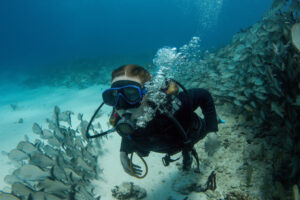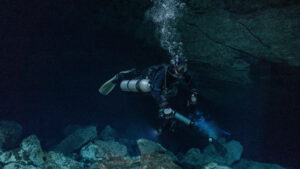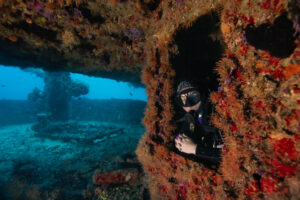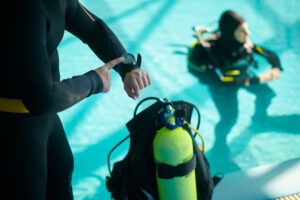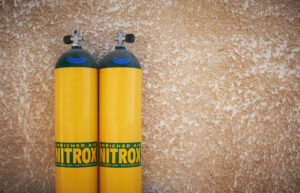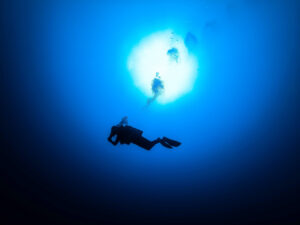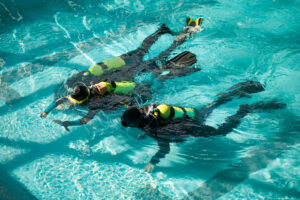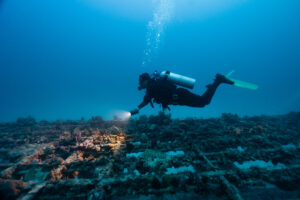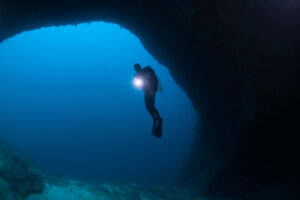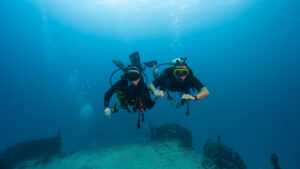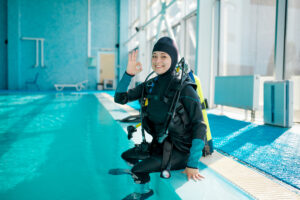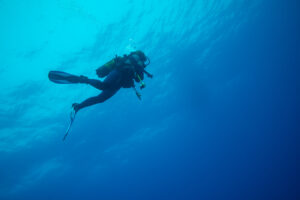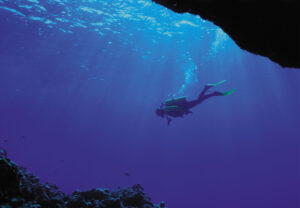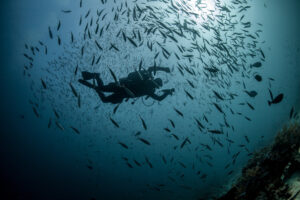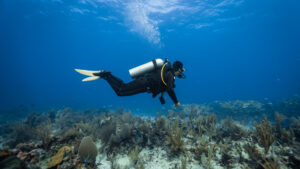What is Aggressive Decompression when Scuba Diving?
Aggressive decompression, a pivotal term within the realm of scuba diving, represents a decompression schedule intending to shorten overall decompression time for a given pre-ascent dive profile. This practice operates on a delicate balance, accepting the increased risk of decompression sickness to diminish overall ascent time, which can be advantageous in particular circumstances. Understanding aggressive decompression necessitates a basic comprehension of the principles of decompression itself.
Decompression is a physiological process that divers must undergo when surfacing from a deep dive. As a diver descends, the pressure of the surrounding water increases. This forces more air into the diver’s body, which can lead to a higher concentration of nitrogen in the tissues. Upon ascent, the pressure decreases, and the excess nitrogen must be expelled gradually to avoid bubbles forming in the body—a condition known as decompression sickness, or ‘the bends’.
The Mechanics of Aggressive Decompression
The primary appeal of aggressive decompression is its ability to minimize the total time spent underwater. This speedier ascent can be crucial in emergency situations or when conditions are less than ideal, such as low air supply, hazardous marine life, or rough sea conditions. However, it’s important to note that the reduction in decompression time is achieved at the expense of safety, heightening the risk of decompression sickness.
When following an aggressive decompression schedule, a diver will ascend at a faster rate than standard protocols recommend. This brisk ascent doesn’t allow for complete nitrogen expulsion from the body, making it imperative for the diver to carefully manage their ascent rate, and closely monitor their physical condition upon surfacing.
Dive Computers and Aggressive Decompression
A dive computer is a vital tool when executing aggressive decompression. These devices monitor a diver’s depth and time underwater, calculating the rate of nitrogen absorption in the body and providing real-time updates on decompression requirements. Dive computers often have adjustable settings, allowing divers to select an aggressive decompression schedule if needed.
Relying on a dive computer for aggressive decompression, however, should not replace comprehensive training and knowledge. Divers should fully understand the potential risks and physiological effects associated with the practice. Awareness of early signs of decompression sickness, including joint pain, dizziness, and fatigue, is crucial.
Decompression Stops and Aggressive Decompression
Decompression stops, periods where divers halt their ascent to allow nitrogen to safely leave their bodies, are significantly shortened in an aggressive decompression strategy. Divers might reduce the duration of each stop, eliminate certain stops, or both. Regardless of the exact method, the goal remains to surface faster while still preventing decompression sickness to the best extent possible.
While divers might feel time-crunched at the surface, it is essential not to rush these stops, even when following an aggressive schedule. The consequences of decompression sickness far outweigh the benefits of a quick return to the surface.
Risks and Consequences of Aggressive Decompression
While aggressive decompression offers some advantages, the practice carries considerable risks that shouldn’t be ignored. Foremost among these is the heightened risk of decompression sickness (DCS). In severe cases, DCS can lead to serious neurological damage or even death.
Although a more rapid ascent may be necessary in certain situations, divers must weigh the pros and cons. If the conditions allow for a standard ascent, it is always the safer choice. Divers should only resort to aggressive decompression when there’s a compelling reason that justifies the increased risk.
Understanding Decompression Sickness (DCS)
DCS, or ‘the bends’, occurs when the
excess nitrogen in a diver’s tissues forms bubbles as pressure decreases during ascent. Mild symptoms include joint and muscle pain, skin rash, and fatigue. More severe manifestations include paralysis, unconsciousness, and in the worst cases, death.
Nitrogen bubbles can occur throughout the body, but common sites include joints, lungs, heart, and brain. In some cases, symptoms can be delayed by several hours, making it critical for divers to monitor their health even after they’ve left the water.
Prevention and Treatment of DCS
Preventing DCS is the key to safe diving practices. This involves adhering to established decompression schedules, staying well-hydrated, avoiding intense physical activity before and after a dive, and ensuring you’re in good overall health.
In the case of a suspected DCS occurrence, immediate medical attention is required. Treatments often involve oxygen therapy and recompression in a hyperbaric chamber. However, prevention is always better than cure, especially when dealing with a condition as serious as DCS.
Advanced Techniques and Tools in Aggressive Decompression
As scuba diving technology evolves, new techniques and tools emerge to assist with aggressive decompression. These advancements aim to make aggressive decompression safer and more manageable, although it remains a practice that carries significant risk.
Gradient Factors in Decompression Algorithms
Gradient factors are a development in decompression theory used by many modern dive computers. These factors allow divers to customize their decompression algorithm, effectively managing their ascent profile. Divers can adjust the gradient factors to follow a more conservative or aggressive decompression schedule based on their comfort and necessity.
Utilizing gradient factors for aggressive decompression requires a solid understanding of decompression theory and practice. Misuse can result in a too-rapid ascent and increased risk of DCS. Training and careful preparation are essential.
Technical Diving and Aggressive Decompression
Technical diving, which involves diving beyond the normal recreational scuba diving limits, often employs aggressive decompression schedules. Tech divers use specialized equipment and gases like Trimix, a blend of oxygen, helium, and nitrogen, to manage their decompression.
While these advanced techniques and gases can make aggressive decompression somewhat safer, they come with their own risks and require extensive training. These methods are not suitable for casual or inexperienced divers.
The Ethics and Philosophy of Aggressive Decompression
While much of the discussion around aggressive decompression revolves around its practical and physiological implications, there’s also a philosophical debate within the diving community. Some see the practice as a necessary tool in certain circumstances, while others view it as a reckless disregard for safety.
The Ethics of Risk
The decision to follow an aggressive decompression schedule inherently involves an acceptance of risk. From an ethical perspective, the key question becomes: When, if ever, is it appropriate to deliberately expose oneself to a higher risk of injury or death? This consideration extends to dive partners and rescuers, whose safety may be endangered in the event of a DCS incident.
Each diver’s answer will depend on their personal philosophy and understanding of risk. For some, the increased risk is only acceptable in dire situations, while others may be more willing to accept the potential consequences.
The Responsibility of Dive Leaders and Educators
Dive leaders, educators, and certification agencies have a responsibility to inform students about aggressive decompression. This includes the potential benefits, risks, and the fact that it is generally considered an advanced technique.
The teaching of aggressive decompression raises ethical questions about the role of educators in promoting safe diving practices. Encouraging inexperienced divers to use aggressive decompression without proper training or preparation could be seen as irresponsible, highlighting the need for comprehensive education in scuba diving. It underscores the importance of fostering a culture of safety, awareness, and respect for the inherent risks of the underwater environment.
While aggressive decompression might save time, its potential consequences demand serious thought. This fact reinforces the need for rigorous training, thorough preparation, and an unwavering commitment to safety from every member of the diving community.
Future Perspectives on Aggressive Decompression
As diving technology continues to advance, the tools and techniques available for managing decompression will undoubtedly evolve. Future developments may further mitigate the risks of aggressive decompression, providing greater flexibility and safety for divers.
Innovation in Dive Technology
Advancements in dive technology could play a significant role in the future of aggressive decompression. Innovations like more sophisticated dive computers, decompression devices, and materials could provide more accurate decompression calculations and a safer ascent profile, even under aggressive decompression schedules.
While these advancements may help reduce the risk of DCS, they should not replace a fundamental understanding of decompression principles or safe diving practices. Technological aids are merely tools that supplement, not replace, the knowledge and skills of the diver.
Advances in Decompression Research
Research into decompression physiology and the treatment of DCS continues to grow. New insights into how the body absorbs and releases gases under pressure could lead to new decompression models, potentially making aggressive decompression safer in the future.
In addition, ongoing research into the treatment of DCS could lead to more effective treatment protocols, lessening the impact of DCS when it does occur. However, while these advances are promising, prevention and careful planning will always be the most effective measures against decompression sickness.
The Art and Science of Aggressive Decompression
In essence, aggressive decompression is both an art and a science. It represents an intersection of physiology, physics, and personal judgement. It’s an approach where the deep understanding of theoretical concepts merges with practical experience, quick decision-making, and sometimes, the challenging pressures of the underwater world.
Personal Judgement and Experience
The application of aggressive decompression relies heavily on a diver’s personal judgement and experience. There are numerous factors to consider, including dive depth, time, physical condition, and environmental conditions.
It’s also important to remember that every diver is unique, and what works for one may not work for another. Factors such as fitness, age, body composition, and dive experience can all impact how an individual diver responds to aggressive decompression.
The Physics and Physiology of Decompression
Aggressive decompression is deeply rooted in the principles of physics and physiology. Understanding how gases behave under pressure (Henry’s Law), and how our bodies react to changes in pressure, is key to managing aggressive decompression.
The study of decompression involves a complex blend of mathematics, physics, and human biology. It is a field that is continually evolving, driven by ongoing research and advancements in technology.
Aggressive decompression is indeed a captivating topic in the realm of scuba diving, encompassing fascinating aspects of human endurance, scientific exploration, and personal responsibility. It presents a critical challenge and an ethical dilemma for every diver – striking a balance between time efficiency and personal safety. In the world beneath the waves, knowledge is power, and understanding aggressive decompression can be a powerful tool in every diver’s kit.
Training for Aggressive Decompression
Training is crucial when considering aggressive decompression. Given the potential risks involved, it’s essential to have a comprehensive understanding of decompression theory, the ability to recognize and respond to symptoms of DCS, and a thorough knowledge of your own physical capabilities and limitations.
Decompression Theory Training
Decompression theory training involves learning about gas laws, decompression models, and how they relate to dive planning. This forms the foundational knowledge for understanding aggressive decompression and how it impacts the body.
Divers need to understand the principles of partial pressures, nitrogen uptake and elimination, and the risk factors for DCS. This theoretical background is essential for making informed decisions about decompression schedules and managing the inherent risks.
Physical Conditioning and Diving Fitness
Physical conditioning and overall diving fitness play a significant role in how a diver’s body handles decompression. Good physical fitness can improve gas exchange, potentially helping to reduce the risk of DCS.
Training programs focusing on cardiovascular health, strength, and flexibility can enhance a diver’s fitness for aggressive decompression. Furthermore, maintaining a healthy lifestyle, including a balanced diet and adequate rest, can positively influence a diver’s resilience to decompression stress.
The Final Ascent: Aggressive Decompression in Practice
When applied with caution and understanding, aggressive decompression can be a useful tool in a diver’s repertoire. However, it should never be a standard practice, and the potential benefits must always be weighed against the risks.
Real-World Applications of Aggressive Decompression
Aggressive decompression has real-world applications, particularly for technical and commercial divers who may need to reduce their time underwater due to work constraints or emergencies. Rescue divers may also employ aggressive decompression if rapid ascent is crucial to the mission.
However, in recreational diving, the benefits of aggressive decompression are often outweighed by the potential risks. The primary objective should always be to dive safely and within one’s limits.
Beyond the Norm: Extraordinary Scenarios
While the need for aggressive decompression in recreational diving is rare, there may be extraordinary scenarios where its application is justified. This could include a diver with a dwindling air supply, deteriorating environmental conditions, or a medical emergency underwater.
In these situations, the potential harm from remaining underwater could outweigh the risks associated with a quicker ascent. However, it is important to reiterate that such scenarios should be exceptions rather than the rule, and every effort should be made to avoid situations that might necessitate aggressive decompression.
Aggressive decompression is a complex and intricate aspect of diving, grounded in a profound understanding of physiology, physics, and risk management. With the right knowledge, training, and judgement, it can serve as a viable option in specific scenarios. However, the inherent risks demand that divers approach aggressive decompression with caution, respect, and a deep commitment to safety. As the adage goes, “It’s better to be on the surface wishing you were underwater, than underwater wishing you were on the surface.”
The Ever-Evolving Nature of Dive Practices
As with any aspect of diving, the practices and recommendations surrounding aggressive decompression are continually evolving. New research, advancements in technology, and the shared experiences of divers worldwide all contribute to this ongoing development. This dynamic nature is part of what makes diving such a rich and rewarding pursuit.
Lessons from the Dive Community
The global dive community plays a significant role in shaping the practices and understanding of aggressive decompression. Divers, from recreational enthusiasts to technical experts, share their experiences and learnings, contributing to a collective body of knowledge that informs future dive practices.
Incident reports, case studies, and shared anecdotes all provide valuable insights into how aggressive decompression works in real-world scenarios, and what can happen when things go wrong. These lessons can be instrumental in refining training programs and improving safety guidelines.
Looking Ahead: The Future of Aggressive Decompression
Looking to the future, the practice of aggressive decompression may change as new knowledge and technology become available. As we continue to better understand the human body and how it reacts to changes in pressure, we may be able to develop safer and more effective methods of decompression, aggressive or otherwise.
Advanced dive computers, innovative decompression algorithms, and potentially even new gases for breathing could all contribute to the evolution of aggressive decompression. These developments may open up new possibilities for dive exploration, while also improving the safety and accessibility of the sport.
Despite the potential for future advancements, the fundamental principles of safe diving will remain constant. Training, preparation, and a respect for the underwater environment are crucial for any diver, regardless of the techniques or tools they use.
Diving is a realm where science and adventure intersect, a place where curiosity and caution must walk hand in hand. The practice of aggressive decompression is a poignant reminder of this delicate balance, illustrating the complex interplay between exploration and safety, between our desire to dive deep and our biological limitations. It reminds us that beneath the waves, as in life, knowledge and respect for the rules are our most valuable assets.


